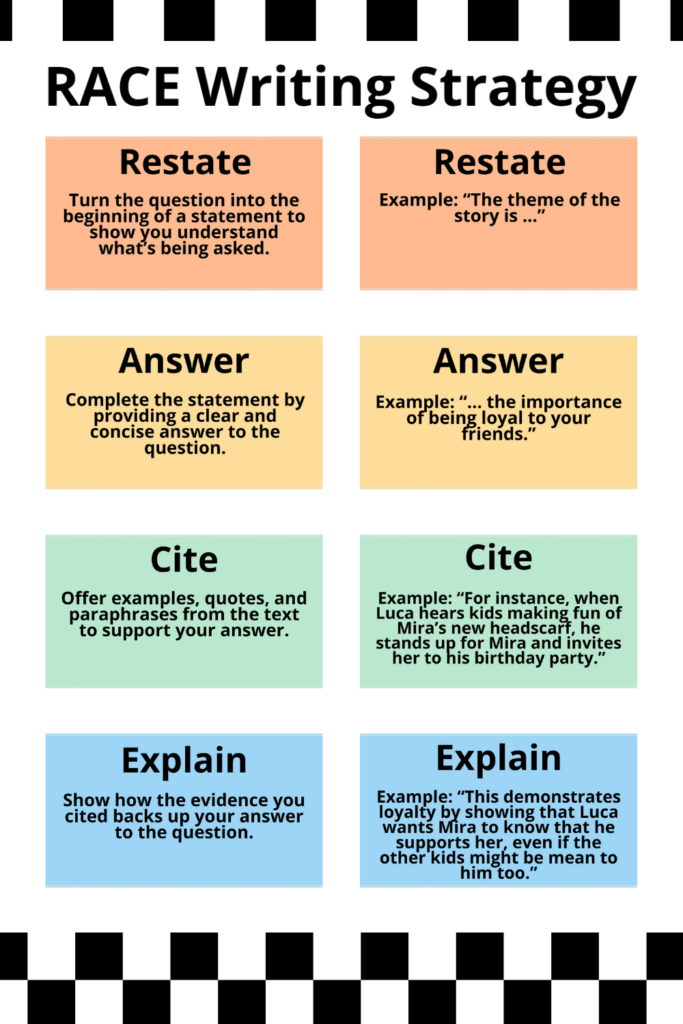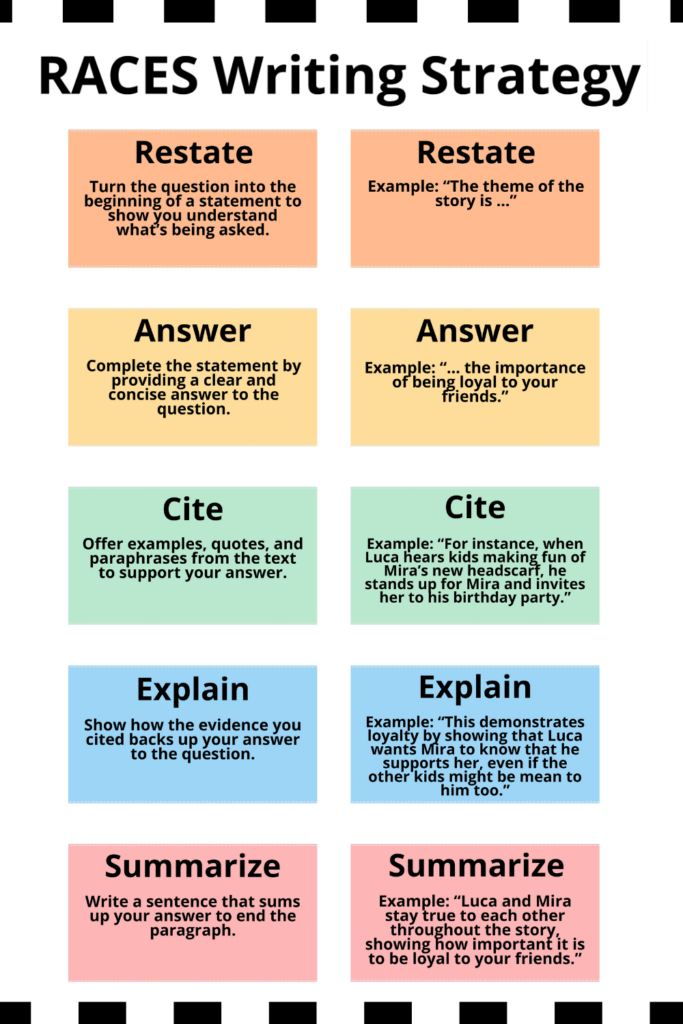
In today’s world, it’s more important than ever for students to be able to articulate their thoughts clearly and concisely through the written word. One easy way to help them strengthen their skills is by using the RACE writing strategy. This structured method guides writers through creating a strong response to reading comprehension and other short-answer questions, including those found on standardized tests. Here’s how it works and how to teach it.
Don’t forget to grab our free printable set of graphic organizers. We’ve included options for both RACE and RACES, in color and black-and-white. Plus, get printable images for an easy RACE/RACES anchor chart!
Jump to:
What is the RACE writing strategy?

This simple method is one of many writing strategies educators use to help students ensure they’re answering questions and writing prompts clearly, concisely, and thoroughly. It’s most commonly used with reading comprehension short-answer essay questions, but it works for any situation where students need to provide a written response in paragraph form.
The easy-to-remember acronym breaks the process into four parts, and the best way to explain it is to see it in action. To explore how the strategy works, we’ll use this passage about penguins:
“Penguins have special ways to live in their cold environments. Their smooth bodies and flippers help them swim fast to catch fish, squid, and krill. Their thick, waterproof feathers keep them warm and dry, and a layer of fat, called blubber, gives them extra warmth and helps them float. Penguins have special behaviors too, like huddling together to stay warm and protect their eggs and babies from the cold. Their black-and-white feathers help them hide from predators by blending in with the ocean. All these things help penguins survive and do well in very cold places.”
Question: How do penguins’ bodies help them survive their environment?
Restate
First, students turn the question into a statement, to ensure they fully understand what’s being asked. The statement is usually open-ended, because they’ll complete the sentence in the second step.
RACE Writing Strategy Example: “Penguins’ bodies help them survive their environment because they …”
Answer
Then, students answer the question with a clear, succinct response. Essentially, they complete the sentence they began in the “Restate” step with a direct answer.
RACE Writing Strategy Example: ” … help them swim fast, protect them against the cold, and hide them from predators.”
Cite
In this key step, students back up their answers by pointing to evidence from the text itself. They may quote or paraphrase what’s written to prove their point.
RACE Writing Strategy Example: “For instance, penguins have smooth bodies and flippers, along with thick black-and-white feathers and blubber.”
Explain
Now, students expand on their citation in their own words, so they’re not just parroting back what they’ve read. They explain how the facts they’ve cited help to answer the question.
RACE Writing Strategy Example: “Their bodies and flippers help them swim fast to catch their favorite foods, and their waterproof feathers and blubber keep them warm in the cold weather. Predators have a hard time seeing them because their black-and-white feathers blend into the landscape.”
How is the RACES writing strategy different?

Some teachers add an S to the RACE strategy, which stands for “Summarize.” This is the conclusion sentence at the end of the response that reinforces the main points in the answer. A complete answer using the RACES strategy might look like this:
“Penguin bodies help them survive their environment because they help them swim fast, protect them against the cold, and hide them from predators. For instance, penguins have smooth bodies and flippers, along with thick black-and-white feathers and blubber. Their bodies and flippers help them swim fast to catch their favorite foods, and their waterproof feathers and blubber keep them warm in the cold weather. Predators have a hard time seeing them because their black-and-white feathers blend into the landscape. All of these body parts help penguins survive in cold and dangerous environments.”
How To Teach the RACE/RACES Writing Strategy
Most teachers begin introducing this method in the mid-elementary years, often around third grade. Continue to use and reinforce it throughout the rest of the elementary years and into the middle grades. By high school, students should be very comfortable with RACE/RACES and consider it an important part of their writing strategies toolbox.
Try these activities and teaching methods to introduce and use this valuable strategy with your students.
Anchor Chart
Create and hang an anchor chart students can refer back to throughout the school year. Make things even easier on yourself by using our free printables to create your chart in no time flat!
Modeling and Guided Practice
As with nearly any strategy, it helps to model the correct behavior for your students first. Use the paragraph above about penguins, or choose any other reading passage you like. Then, walk through the steps together, demonstrating the thinking process and writing out the responses.
Next, provide students with another reading passage (AI can be a real help here, and short stories work too) and a comprehension question. Ask them to work in groups to try out the RACE/RACES model. Share each group’s response with the class, then work together to evaluate, correct, and strengthen them as needed.
Graphic Organizers
This organizational tool is ideal for RACE/RACES. Use our free printables (see below), or encourage kids to draw their own simple chart. They can use these organizers to make notes and sketch out their responses before finalizing their answer in paragraph form.
Color Coding
Pull out your highlighters! After students write their responses using the RACE/RACES method, ask them to highlight the various sections that match each letter of the model (e.g., orange for Restate, yellow for Answer, etc.). This ensures they don’t miss any of the steps in writing a complete response. We’ve included color-coded versions in our graphic organizer set to make the process even easier.
Sentence Starters
Jump-start the process by providing a list of sentence stems and starters. These are especially helpful for the Cite, Explain, and Summarize sections. Try these examples:
Cite
- The passage says …
- As noted in the text …
- The writer tells us that …
- According to the author …
- As mentioned in the article …
Explain
- This shows that …
- The author means …
- This example demonstrates …
- This is how we know that …
- The evidence supports the idea because …
Summarize
- In summary …
- Overall …
- In conclusion …
- Based on these facts …
- For these reasons …
Find more conclusion sentence starters here.


